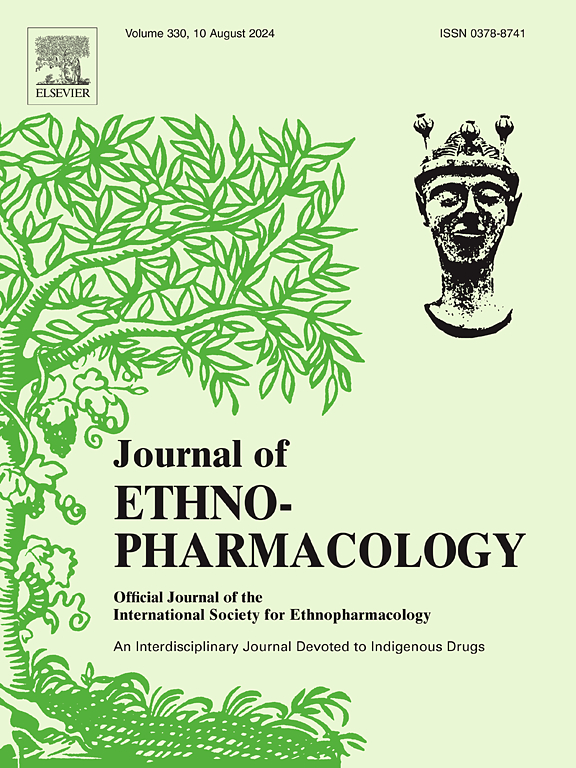ShenJiaoLingCao decoction ameliorates cyclophosphamide-induced splenic injury and immunosuppression via the inhibition of MEK/ERK signaling pathway activity and modulation of amino acid metabolism
IF 4.8
2区 医学
Q1 CHEMISTRY, MEDICINAL
引用次数: 0
Abstract
Ethnopharmacological relevance
ShenJiaoLingCao Decoction (SJLCD) is derived from the classic Chinese medicine prescription, which consists of ten kinds of herbs. In China, SJLCD has been used as an immunomodulator in clinical practice for more than ten years. However, no relevant studies have been done to clarify the pharmacodynamic underpinnings of its regulation of the body's immune system and its related processes.
Aim of the study
This study aims to assess the immunomodulatory effects of SJLCD.
Materials and methods
Ultra performance liquid chromatography-quadrupole-orbitrap mass spectrometry (UPLC-Q-Orbitrap MS) was utilized to characterize the chemical constituents in SJLCD and establish its fingerprint profile. Predicting potential bioactive compounds in SJLCD for immunomodulatory effects and elucidating their mechanisms of action using artificial intelligence technology. Experiments at the animal level were carried out to verify the accuracy of the predictions. Firstly, an immunocompromised model was constructed by intraperitoneal injection of 80 mg/kg of cyclophosphamide (CTX) into rats for 3 consecutive days, and SJLCD was administered by oral administration for 14 days. The immunomodulatory effect of SJLCD on immune organs was verified by evaluating the immune organ index and histopathological examinations using hematoxylin and eosin (H&E) staining. The effect of SJLCD on relevant immune cells was examined by measuring erythrocytes, leukocytes and lymphocytes. The effect of SJLCD on relevant immune molecules was assessed by detecting the levels of tumor necrosis factor-α (TNF-α), interleukin-6 (IL-6), interleukin-1β (IL-1β), matrix metalloproteinase-9 (MMP9), cluster of differentiation 3 (CD3), cluster of differentiation 4 (CD4) and cluster of differentiation 8 (CD8). Western blot was used to verify and analyze the possible immunomodulatory mechanisms of SJLCD. Finally, serum untargeted metabolomics was used to detect the differential metabolites of SJLCD in immunocompromised rats.
Results
In this study, a total of 91 compounds were identified in the SJLCD, and the results showed a high degree of similarity (S1-S11 > 0.935) among the 11 samples in positive ion mode. Artificial intelligence computer techniques predicted that quercetin, kaempferol, and fumarine in SJLCD bound better to core targets, especially MAPK1. On animal-level validation, it was found that from an immune organ perspective, SJLCD ameliorated CTX-induced thymus and spleen damage. From an immune cell perspective, SJLCD significantly increased peripheral erythrocyte, leukocyte and lymphocyte counts in immunocompromised rats. From the immune molecular level, SJLCD down-regulated the levels of TNF-α, IL-6, IL-1β, MMP9, CD8 and up-regulated the level of CD3 and CD4 which normalize its secretion. Mechanistically, SJLCD regulates immunity possibly through the MEK/ERK signaling pathway and by affecting amino acid metabolism.
Conclusion
In the present study, we found that SJLCD has satisfactory immunomodulatory activity, which may be achieved by affecting the MEK/ERK signaling pathway and amino acid metabolism of the body.

参胶灵草汤通过抑制MEK/ERK信号通路活性和调节氨基酸代谢改善环磷酰胺诱导的脾损伤和免疫抑制
参教灵草汤(SJLCD)是由中药经典方剂衍生而成,由十种中草药组成。在中国,SJLCD作为一种免疫调节剂已在临床实践中使用了十多年。然而,没有相关的研究来阐明其调节人体免疫系统及其相关过程的药效学基础。本研究旨在探讨SJLCD的免疫调节作用。材料与方法采用高效液相色谱-四极杆-轨道阱质谱(UPLC-Q-Orbitrap MS)对SJLCD中的化学成分进行表征,并建立指纹图谱。利用人工智能技术预测SJLCD中潜在的生物活性化合物的免疫调节作用并阐明其作用机制。为了验证预测的准确性,在动物水平上进行了实验。首先,大鼠腹腔注射环磷酰胺(CTX) 80 mg/kg,连续3 d建立免疫功能低下模型,SJLCD连续14 d口服。通过苏木精和伊红(H&;E)染色评价免疫器官指数和组织病理学检查,验证SJLCD对免疫器官的免疫调节作用。通过测定红细胞、白细胞和淋巴细胞,观察SJLCD对相关免疫细胞的影响。通过检测肿瘤坏死因子-α (TNF-α)、白细胞介素-6 (IL-6)、白细胞介素-1β (IL-1β)、基质金属蛋白酶-9 (MMP9)、分化簇3 (CD3)、分化簇4 (CD4)和分化簇8 (CD8)水平,观察SJLCD对相关免疫分子的影响。Western blot验证和分析SJLCD可能的免疫调节机制。最后,采用血清非靶向代谢组学方法检测免疫功能低下大鼠SJLCD的差异代谢物。结果在SJLCD中共鉴定出91个化合物,结果具有高度的相似性(S1-S11 >;0.935)。人工智能计算机技术预测,SJLCD中的槲皮素、山奈酚和富马碱能更好地与核心靶点结合,尤其是MAPK1。在动物水平上验证,从免疫器官的角度来看,SJLCD改善了ctx诱导的胸腺和脾脏损伤。从免疫细胞的角度来看,SJLCD显著增加了免疫功能低下大鼠的外周血红细胞、白细胞和淋巴细胞计数。在免疫分子水平上,SJLCD下调TNF-α、IL-6、IL-1β、MMP9、CD8水平,上调CD3、CD4水平,使其分泌正常。在机制上,SJLCD可能通过MEK/ERK信号通路和影响氨基酸代谢来调节免疫。结论在本研究中,我们发现SJLCD具有令人满意的免疫调节活性,这可能是通过影响MEK/ERK信号通路和机体氨基酸代谢来实现的。
本文章由计算机程序翻译,如有差异,请以英文原文为准。
求助全文
约1分钟内获得全文
求助全文
来源期刊

Journal of ethnopharmacology
医学-全科医学与补充医学
CiteScore
10.30
自引率
5.60%
发文量
967
审稿时长
77 days
期刊介绍:
The Journal of Ethnopharmacology is dedicated to the exchange of information and understandings about people''s use of plants, fungi, animals, microorganisms and minerals and their biological and pharmacological effects based on the principles established through international conventions. Early people confronted with illness and disease, discovered a wealth of useful therapeutic agents in the plant and animal kingdoms. The empirical knowledge of these medicinal substances and their toxic potential was passed on by oral tradition and sometimes recorded in herbals and other texts on materia medica. Many valuable drugs of today (e.g., atropine, ephedrine, tubocurarine, digoxin, reserpine) came into use through the study of indigenous remedies. Chemists continue to use plant-derived drugs (e.g., morphine, taxol, physostigmine, quinidine, emetine) as prototypes in their attempts to develop more effective and less toxic medicinals.
 求助内容:
求助内容: 应助结果提醒方式:
应助结果提醒方式:


